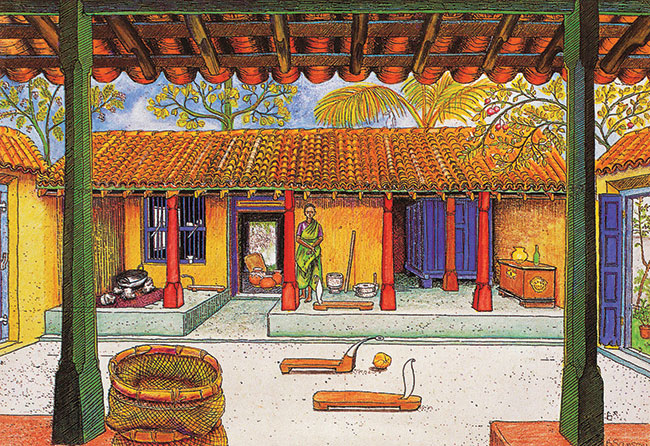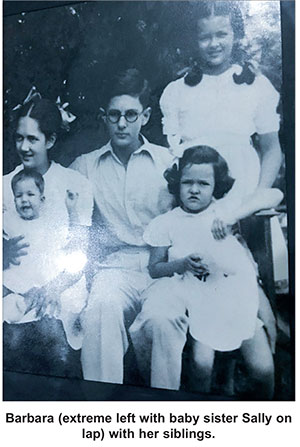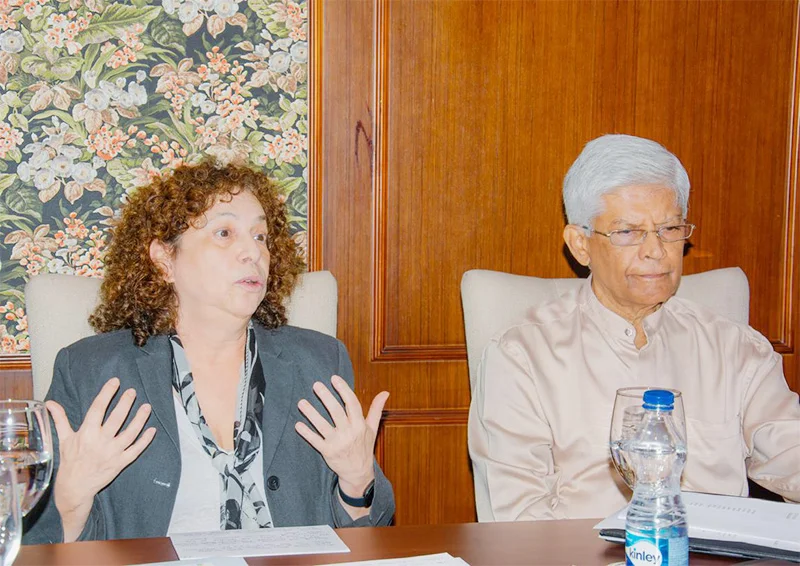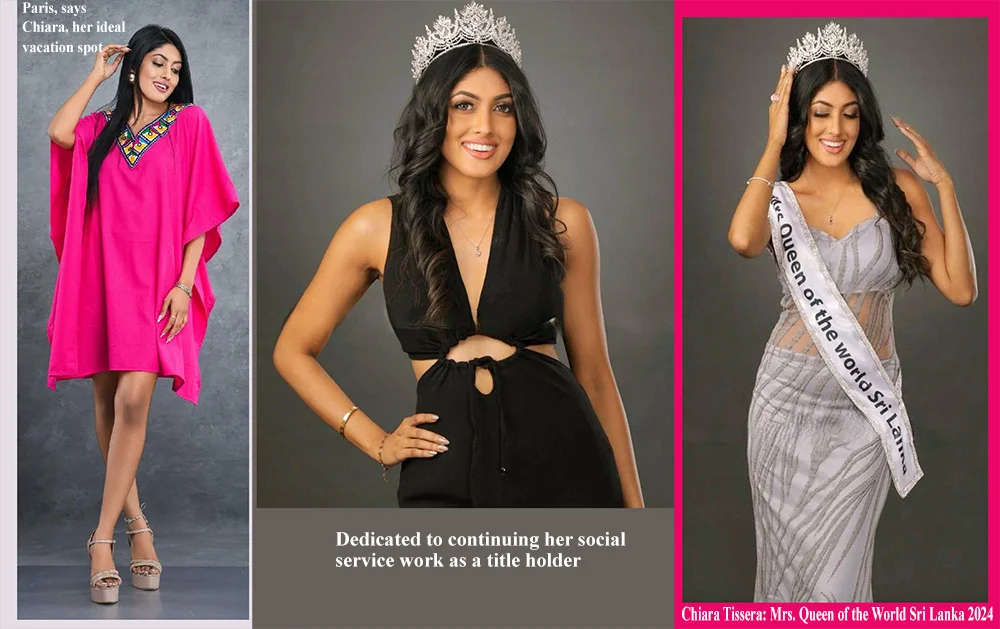Features
Death of Barbara Carolyn Sansoni Lewcock

A rich life comes to an end
Barbara’s extraordinary life came to an end on April 23, 2022. Much has been written and will be written of her work by the cognoscenti in the Art world. My impressions and conclusions on her life and her significance is based on observations made directly and indirectly over 70 years. This article is mostly about the ambience that influenced her as she progressed to become an iconic figure. It would be appropriate to say at the outset that a person who had the foremost influence on her life to become a great artist was her devoted husband Professor Ronald Lewcock.
Barbara lived 94 years. Much has happened in the country during this very long period. She was fortunate to witness at close quarters to the centres of power the changes that were taking place . From a relatively docile well managed British Colony it has changed, to what it is today, a sovereign democratic nation with its vibrant people tearing themselves apart without impunity and totally unaware of what the future will bring.
Barbara’s father was Reginald Young Daniel, who was a War Civil Servant. Straight from Oxford, Reginald had joined the British Forces in World War I. He was wounded twice, the first time in the battle for High Wood on the Somme, and the second time when he was an Officer in the 13th Battalion of the Royal Fusiliers at Cambrai. After the war he was one of four World War Veterans who were selected to the Civil Service. This meant that he had to serve as a Magistrate, a District Judge, an Assistant Government Agent and a Government Agent apart from several other official functions. He had to move all over the country. Together with her parents, Barbara was able to see the entirety of the country first hand.

Barbara was born in Sri Lanka to a Burgher family whose established ancestry goes back to Germany and the Netherlands and to Ireland and England. Strangely, there was a streak or better said a strong vein which attached her to this island. When others related or close to her left the country, she remained and worked out a comfortable but refined existence here. With her genius she proceeded to try to help the country to find its soul in the broader world.
Living in this beautiful island bathed with sunshine, she plucked the colours from her environment and with that inspiration wove exquisite fabrics. Her colour combinations are distinct and universally recognized. I remember standing at the crowded Marktplatz in Stuttgart, Germany in the 1980s, when a lady carrying a bag passed us and my friend turned round to me and remarked that the bag was a Barbara Sansoni creation made with her handloom fabric. At that moment I realized how distinct her combination of colours were to be singled out in a far off land, in the midst of a teeming crowd.
When my wife Sally and I married 54 years ago, Barbara wove a piece of cloth which was tailored into my wedding suit. Sally’s cloth and jacket was also made with a Barbara Sansoni handloom. So were the dresses of the bridesmaids, Ranji Krone and Sussanah van Langenberg. The two page boys Simon and Dominic Sansoni donned their garbs with the same material. We were gifted a beautiful piece of cloth, an indigenous creation, hand woven, made by a supremely gifted craftswoman Barbara herself, and here we are looking back on it 54 years later.
Barbara had an inbuilt self confidence which gave her a make up to have faith in what she did and make the simplest object or the simplest act embellished by her touch. This enabled Barbara to make an enormous contribution to social change in the field of clothing in the tradition bound Sri Lankan society. Here, the town folk had adopted sarees, an essentially Indian creation as the accepted dress for women, and trousers and the suits introduced by the British had almost totally replaced the sarong. What had started in colonial times gripped the country post independence. Barbara set the pace for a fresh look. Together with a classmate of mine, Laki Senanayake, who worked closely with Barbara, she introduced a change to cloth and jacket and sarongs. Laki also worked with Ena de Silva and created masterpieces using the batik techniques.
Barbara’s brand name became Barefoot, changing from the original Barbara Sansoni Fabrics. Barefoot embraced fabrics; setup exclusive boutiques, in Colombo and Galle, Sydney and Seoul Korea; a bookshop, a Gallery, a pulsating café where cross cultural groups were at ease over a cup of tea or listening to Jazz. Barefoot also was the home of the Gratiaen Prize, the Sri Lankan equivalent of the Booker Prize, a Prize initiated by Booker laureate Michael Ondaatje and named after his mother’s family. The late Hildon Sansoni and Michael’s mother were first cousins.
Barbara in her individual capacity and in collaboration with others was also the author of several books.
Teaming up with Geoffrey Bawa, Barbara and Laki supported by Ismeth Rahim, Ulrik Plessner and Anjalendram and a large number of other artists worked ovr time to evolve and usher in an indigenous architectural ethos and style.
Geoffrey Bawa and Barbara had grown up like siblings, though there was a generation gap. Geoffrey’s father, Benny Bawa, and Barbara’s grandfather, James Albert van Langenberg were legal luminaries and both very close friends. Benny had deviled under James Albert’s father. Every morning the two friends traveled together from their homes to Hulftsdorp in a horse and carriage. Van Langenberg lived at Merten in Guildford Crescent and Bawa at Chapman House, Darley Road. Their wives were also so close that Barbara’s mother Bertha inherited her name from Geoffrey’s mother.
Like the Bawas, the Spittels were close to the Daniel family. Mrs R.L.Spittel’s mother was a sister of A.Y.Daniel’s wife, Barbara’s grandmother. Christine Wilson, R.L.Spittel’s daughter, though older than Barbara remained close to her all her life.
Another family Barbara’ parents were fond of were the Barbers. This quotation from R.Y.Daniel’s diary describes it best:
“Your Uncle Cyril Barber owned 800 acres of the best cocoa in the Island, in Ukuwela. Barber’s Cocoa was much appreciated in the First World War. We ate it in the trenches. Cyril was responsible for that high standard of chocolate.
“After the war, to enable his brothers, who had been on active service, to come out and take a share in the family business, he moved to “Blackstone” in Mahawella, which he owned. After his brothers returned to England and one of them, Jim, had died, Cyril’s son Reginald went to Ukuwela. The estate was called “The Grove”.
“You, my dear children, will remember the happy times which you spent at Blackstone, which was a second home to us. Your Uncle Cyril and Aunt Edo were excellent hosts and loved to have the members of the family around them. Cyril manufactured his own cigars, liquor, vinegar, kept poultry and cattle and grew most of his foodstuffs. All this was much appreciated by his guests. Everything was of such a high quality”.
It was at Lukkanon, however, the home of Ern and Etta Mack that Barbara felt happiest. Here she was received by her aunts and uncles and grandmother who were all living there. Her genius was recognized but so was her eccentricities accepted without reservations. The good, the great and those in need visited this house but all received the same welcome. Lukkanon has gained historical significance after Michael Ondaatje featured it in the internationally acclaimed best seller “Running in the family”.
Barbara’s grandmother, Ethel Van Langenberg was herself an artist. She was adept at doing miniature paintings. Ethel and her daughters were very committed to works of charity.
The van Langenbergs were devout Roman Catholics. It was therefore natural for the Irish nuns Sister Canice and Sister Good Council of the Good Shepherd Order in Ceylon to ask Barbara to help the mothers in need who they were looking after to be trained for a meaningful job and if possible to give them a livelihood. What Barbara has done on this subject in the last 70 years is phenomenal.
A H
Features
SL urged to use GSP+ to the fullest to promote export development

 Sri Lanka needs to take full stock of its current economic situation and use to the maximum the potential in its GSP+ facility for export sector growth. In the process, it should ensure that it cooperates fully with the European Union. The urgency of undertaking these responsibilities is underscored by the issues growing out of the recent US decision to sweepingly hike tariffs on its imports, though differentially.
Sri Lanka needs to take full stock of its current economic situation and use to the maximum the potential in its GSP+ facility for export sector growth. In the process, it should ensure that it cooperates fully with the European Union. The urgency of undertaking these responsibilities is underscored by the issues growing out of the recent US decision to sweepingly hike tariffs on its imports, though differentially.
These were principal ‘takes’ for participants in the Pathfinder Foundation’s Ambassadors’ Roundtable forum held on April 8th at the Colombo Club of the Taj Samudra. The main presenter at the event was Ms. Carmen Moreno Raymundo, Ambassador of the European Union to Sri Lanka and the Maldives. The forum was chaired by Ambassador Bernard Goonetilleke, Chairman, Pathfinder Foundation. The event brought together a cross-section of the local public, including the media.
Ms. Moreno drew attention to the fact Sri Lanka is at present severely under utilizing its GSP+ facility, which is the main means for Sri Lanka to enter the very vast EU market of 450 million people. In fact the EU has been Sri Lanka’s biggest trading partner. In 2023, for instance, total trade between the partners stood at Euros 3.84 billion. There is no greater market but the EU region for Sri Lanka.
‘However, only Sri Lanka’s apparel sector has seen considerable growth over the years. It is the only export sector in Sri Lanka which could be said to be fully developed. However, wider ranging export growth is possible provided Sri Lanka exploits to the fullest the opportunities presented by GSP+.’
Moreno added, among other things: ‘Sri Lanka is one among only eight countries that have been granted the EU’s GSP+ facility. The wide-ranging export possibilities opened by the facility are waiting to be utilized. In the process, the country needs to participate in world trade in a dynamic way. It cannot opt for a closed economy. As long as economic vibrancy remains unachieved, Sri Lanka cannot enter into world trading arrangements from a strong position. Among other things, Sri Lanka must access the tools that will enable it to spot and make full use of export opportunities.
‘Sri Lanka must facilitate the private sector in a major way and make it possible for foreign investors to enter the local economy with no hassle and compete for local business opportunities unfettered. At present, Lanka lacks the relevant legal framework to make all this happen satisfactorily.
‘Sri Lanka cannot opt for what could be seen as opaque arrangements with bilateral economic partners. Transparency must be made to prevail in its dealings with investors and other relevant quarters. It’s the public good that must be ensured. The EU would like to see the local economy further opening up for foreign investment.
‘However, it is important that Sri Lanka cooperates with the EU in the latter’s efforts to bring about beneficial outcomes for Sri Lankans. Cooperation could be ensured by Sri Lanka fully abiding by the EU conditions that are attendant on the granting of GSP+. There are, for example, a number of commitments and international conventions that Sri Lanka signed up to and had promised to implement on its receipt of GSP+ which have hitherto not been complied with. Some of these relate to human rights and labour regulations.
‘Successive governments have pledged to implement these conventions but thus far nothing has happened by way of compliance. GSP+ must be seen as an opportunity and not a threat and by complying with EU conditions the best fruits could be reaped from GSP+. It is relevant to remember that GSP+ was granted to Sri Lanka in 2005. It was suspended five years later and restored in 2017.
‘The importance of compliance with EU conditions is greatly enhanced at present in view of the fact that Sri Lanka is currently being monitored by the EU with regard to compliance ahead of extending GSP+ next year. A report on Sri Lanka is due next year wherein the country’s performance with regard to cooperating with the EU would be assessed. The continuation of the facility depends on the degree of cooperation.
‘A few statistics would bear out the importance of Sri Lanka’s partnership with the EU. For example, under the facility Sri Lanka benefits from duty free access in over 66% of EU tariff lines. The highest number of tourist arrivals in Sri Lanka in 2023 was from the EU’s 27 member states. Likewise, the EU’s 27 member states rank second in the origin of inflows of foreign exchange to Sri Lanka; with Italy, France and Germany figuring as the main countries of origin. Eighty five percent of Sri Lanka’s exports to the EU market benefits from GSP+. Thus, the stakes for the country are high.’
Meanwhile, President, In-house Counsel & Legal Advisor, The European Chamber of Commerce of Sri Lanka, John Wilson said: ‘GSP+ should be seen as not only an opportunity but also as a necessity by Sri Lanka in the current international economic climate. ‘Implementation of local laws is what is needed. Considering the pressures growing out of the US imposed new tariff regime, a good dialogue with the EU is needed.
‘Sri Lanka’s level of business readiness must be upped. Among the imperatives are: An electronic procurement process, Customs reforms, a ‘National Single Window’, stepped-up access to land by investors, for example, a clear policy framework on PPPs and reform of the work permits system.’
It ought to be plain to see from the foregoing that Sri Lanka cannot afford to lose the GSP+ facility if it is stepped-up economic growth that is aimed at. It would be in Sri Lanka’s best interests to remain linked with the EU, considering the aggravated material hardships that could come in the wake of the imposition of the US’ new tariff regime. Sri Lanka would need to remain in a dialogue process with the EU, voice its reservations on matters growing out of GSP+, if any, iron out differences and ensure that its national interest is secured.
Features
SENSITIVE AND PASSIONATE…

Chit-Chat
Chiara Tissera
Mrs. Queen of the World Sri Lanka 2024, Chiara Tissera, leaves for the finals, in the USA, next month
I had a very interesting chat with her and this is how it all went:
1. How would you describe yourself?
I am a sensitive and passionate individual who deeply cares about the things that matter most to me. I approach life with a heart full of enthusiasm and a desire to make meaningful connections.
2. If you could change one thing about yourself, what would it be?
Actually, I wouldn’t change a thing about myself because the person I am today, both inside and out, is the result of everything I’ve experienced. Every part of me has shaped who I am, so I embrace both my strengths and imperfections as they make me uniquely me.
3. If you could change one thing about your family, what would it be?
If there’s one thing I could change about my family, it would be having my father back with us. Losing him six years ago left a void that can never be filled, but his memory continues to guide and inspire us every day.
4. School?
I went to St. Jude’s College, Kurana, and I’m really proud to say that the lessons I gained during my time there have shaped who I am today. My school and teachers instilled in me values of hard work, perseverance and the importance of community, and I carry those lessons with me every day. I was a senior prefect and was selected the Deputy Head Prefect of our college during my tenure.
5. Happiest moment?
The happiest moment of my life so far has been winning the Mrs. Sri Lanka 2024 for Queen of the World. It was a dream come true and a truly unforgettable experience, one that fills me with pride and gratitude every time I reflect on it.
6. What is your idea of perfect happiness?
Happiness is a deeply personal and multifaceted feeling that often comes from a sense of contentment, fulfillment and well-being. For me, perfect happiness is in moments of joy, peace and accomplishments … and also being surrounded by my loved ones.
7. Are you religious?
Yes, I’m a very religious person. And I’m a firm believer in God. My faith guides me through life, providing strength, dedication and a sense of peace in every situation. I live by the quote, ‘Do your best, and God will do the rest.’
8. Are you superstitious?
I’m not superstitious. I believe in making my own decisions and relying on logic and faith rather than following superstitions.
9. Your ideal guy?
My ideal guy is my husband. He is compassionate, understanding and is always there to support me, no matter what. He’s my rock and my best friend – truly everything I could ever want in a partner.
10. Which living person do you most admire?
The living person I admire the most is definitely my mummy. Her strength, love and unwavering support has shaped me into who I am today. She is my role model and she inspires me every day with her wisdom and kindness.
11. Your most treasured possession?
My most treasured possession is my family. They are the heart of my life, providing me with love, support and strength. Their presence is my greatest blessing.
12. If you were marooned on a desert island, who would you like as your companion?
I would like to have my spouse as my companion. Together, we could make the best of the situation, supporting each other, sharing moments of laughter and finding creative ways to survive and thrive.
13. Your most embarrassing moment?
There’s quite a few, for sure, but nothing is really coming to mind right now.
14. Done anything daring?
Yes, stepping out of my comfort zone and taking part in a pageant. I had no experience and was nervous about putting myself out there, but I decided to challenge myself and go for it. It pushed me to grow in so many ways—learning to embrace confidence, handle pressure, and appreciate my own uniqueness. The experience not only boosted my self-esteem but also taught me the value of taking risks and embracing new opportunities, even when they feel intimidating.”
15. Your ideal vacation?
It would be to Paris. The city has such a magical vibe and, of course, exploring the magical Eiffel Tower is in my bucket list. Especially the city being a mix of history culture and modern life in a way that feels timeless, I find it to be the ideal vacation spot for me.
16. What kind of music are you into?
I love romantic songs. I’m drawn to its emotional depth and the way they express love, longing a connection. Whether it’s a slow ballad, a classic love song or a more modern romantic tune these songs speak to my heart.
17. Favourite radio station?
I don’t have a specific radio station that I like, but I tend to enjoy a variety of stations, depending on my mood. Sometimes I’ll tune into one for a mix of popular hits, other times I might go for something more relaxing, or a station with a certain vibe. So I just like to keep it flexible and switch it up.
18. Favourite TV station?
I hardly find the time to sit down and watch TV. But, whenever I do find a little spare time, I tend to do some spontaneous binge – watching, catching whatever interesting show is on at that moment.
19 What would you like to be born as in your next life?
Mmmm, I’ve actually not thought about it, but I’d love to be born as someone who gets to explore the world freely – perhaps a bird soaring across continents.
20. Any major plans for the future?
Let’s say preparing and participating in the international pageant happening in the USA this May. It’s an exciting opportunity to represent myself and my country on a global stage. Alongside this, I am dedicated to continuing my social service work as a title holder, striving to make a meaningful difference in the lives of others through my platform.
Features
Fresher looking skin …

 The formation of wrinkles and fine lines is part of our ageing process. However, if these wrinkles negatively impact appearance, making one look older than they actually are, then trying out some homemade remedies, I’ve listed for you, this week, may help in giving your skin a fresher look.
The formation of wrinkles and fine lines is part of our ageing process. However, if these wrinkles negatively impact appearance, making one look older than they actually are, then trying out some homemade remedies, I’ve listed for you, this week, may help in giving your skin a fresher look.
* Banana:
Bananas are considered to be our skin’s best friend. They contain natural oils and vitamins that work very perfectly to boost our skin health. Skincare experts recommend applying the banana paste to the skin.
Take a ripe banana and mash a quarter of it until it becomes a smooth paste. Apply a thin layer of the banana paste on your skin and allow it to sit for 15 to 20 minutes before washing it off with warm water.
* Olive Oil:
Olive oil works as a great skin protector and many types of research suggest that even consuming olive oil may protect the skin from developing more wrinkles. Olive oil contains compounds that can increase the skin’s collagen levels. Yes, olive oil can be used as a dressing on your salads, or other food, if you want to consume it, otherwise, you can apply a thin layer of olive oil on your face, neck and hands and let it stay overnight.
* Ginger:
Ginger serves to be a brilliant anti-wrinkle remedy because of the high content of antioxidants in it. Ginger helps in breaking down elastin, which is one of the main reasons for wrinkles. You can have ginger tea or grate ginger and have it with honey, on a regular basis.
* Aloe Vera:
The malic acid present in Aloe Vera helps in improving your skin’s elasticity, which helps in reducing your wrinkles. Apply the gel once you extract it from the plant, and leave it on for 15-20 minutes. You can wash it off with warm water.
* Lemons:
Lemons contain citric acid, which is a strong exfoliant that can help you get rid of your dead skin cells and wrinkles. Also, as an astringent and a cleansing agent, it helps to fade your wrinkles and fine lines. You can gently rub a lemon slice in your wrinkled skin and leave it on for 10-15 minutes. Rinse afterwards and repeat this process two to three times a day.
* Coconut Oil:
Coconut oil contains essential fatty acid that moisturises the skin and helps to retain its elasticity. You can directly apply the coconut oil, and leave it overnight, after gently massaging it, for the best results.
-

 Business3 days ago
Business3 days agoColombo Coffee wins coveted management awards
-

 Business5 days ago
Business5 days agoDaraz Sri Lanka ushers in the New Year with 4.4 Avurudu Wasi Pro Max – Sri Lanka’s biggest online Avurudu sale
-

 Features4 days ago
Features4 days agoStarlink in the Global South
-

 Business6 days ago
Business6 days agoStrengthening SDG integration into provincial planning and development process
-

 Business5 days ago
Business5 days agoNew SL Sovereign Bonds win foreign investor confidence
-

 Features1 day ago
Features1 day agoSri Lanka’s Foreign Policy amid Geopolitical Transformations: 1990-2024 – Part III
-

 Features4 days ago
Features4 days agoModi’s Sri Lanka Sojourn
-

 Midweek Review1 day ago
Midweek Review1 day agoInequality is killing the Middle Class











